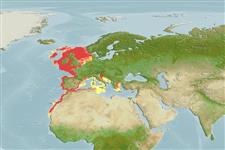分類 / Names
共通名の | 類義語 | Catalog of Fishes(部類, 種) | ITIS | CoL | WoRMS | Cloffa
板鰓亜鋼(サメとエイ類) (sharks and rays) >
Rajiformes (Skates and rays) >
Rajidae (Skates)
Etymology: Raja: Latin, raja, -ae = a sting ray (Raja sp.) (Ref. 45335).
Eponymy: Colonel George Montagu (1751–1815) was a soldier and natural history writer. [...] (Ref. 128868), visit book page.
More on author: Fowler.
Environment: milieu / climate zone / depth range / distribution range
生態学
海 底生の; 深さの範囲 8 - 530 m (Ref. 88171). Temperate; 61°N - 16°N, 18°W - 25°E
Eastern Atlantic: Shetlands, southern North Sea and the western Baltic to Mauritania, including the western part of the Mediterranean (to Tunisia and western Greece).
Length at first maturity / サイズ / 重さ / 年齢
Maturity: Lm 61.0 range ? - ? cm
Max length : 102 cm TL オス/雌雄の選別がない; (Ref. 6014); common length : 50.0 cm TL オス/雌雄の選別がない; (Ref. 3261); 最大記録サイズ: 18 年 (Ref. 88187)
簡単な記述
検索表 | 形態学 | 形態計測学
背面の脊椎 (合計) : 0; 肛門の骨: 0. Sub-rhomboid in shape with a short rostrum and rounded wing-tips. Upper surface almost smooth in young, but prickly in large specimens, except for bare centers of pectoral fins and hind part of disc, underside nearly smooth; orbital thorns separate, a regular row of 20-50 usually persistent thorns from nape to first dorsal fin; with 1-2 thorns between dorsal fins; 2 equal-sized dorsal fins at end of tail. Brownish dorsally with numerous small dark spots which do not reach the margin of the disc, frequently with a concentration of dark spots forming a ring around a pale centre on hind part of each pectoral fin, underside white (Ref. 3167).
Found mainly along the continental shelf (Ref. 3167). Depth range from 8-283 m in the northeast Atlantic (Ref. 82399), in the southern part of its range it occurs down to 530 m (Ref. 78469, 89037), but most common between 20-120 m (Ref. 88187). Prefers habitats with sand or mud bottoms (Ref. 78469). Juveniles usually found in shallow sandy inshore areas, adults utilize more offshore sand or sand-gravel habitats (Ref. 82399, 89038). Species buries itself to avoid predation and ambush potential prey. Feeds mainly on crustaceans (Ref. 3167) with prey size increasing as it grows (Ref. 88171), also preys on benthic worms, cephalopods and small fishes (Ref. 41849, 58137). Most individuals attain a length of 40-60 cm (Ref. 3261). Oviparous. Young may tend to follow large objects, such as their mother (Ref. 205). Detects weak electric fields generated by other organisms and generate its own weak electric fields (Ref. 10311).
Life cycle and mating behavior
成熟 | 繁殖 | 放精 | 卵 | 生産力 | 幼生
Oviparous. Distinct pairing with embrace. Paired eggs are laid during summer (Ref. 3167). Eggs are oblong capsules with stiff pointed horns at the corners deposited in sandy or muddy flats (Ref. 205). Egg capsules are 5.3-7.8 cm long and 3.0-5.0 cm wide (Ref. 41250). Fully formed pups hatch after about 5-6 months and are about 11-12 cm in length (Ref. 78469, 88187).
McEachran, J.D. and K.A. Dunn, 1998. Phylogenetic analysis of skates, a morphologically conservative clade of elasmobranchs (Chondrichthyes: Rajidae). Copeia 1998(2):271-290. (Ref. 27314)
IUCNのレッドリストの状況は (Ref. 130435: Version 2024-1)
Human uses
水産業: 少数商業の
用具
特記事項
XMLをダウンロードして下さい
インターネットの情報源
Estimates based on models
Preferred temperature (Ref.
123201): 7 - 16, mean 9.9 °C (based on 418 cells).
Phylogenetic diversity index (Ref.
82804): PD
50 = 0.5000 [Uniqueness, from 0.5 = low to 2.0 = high].
Bayesian length-weight: a=0.00240 (0.00193 - 0.00299), b=3.25 (3.21 - 3.29), in cm total length, based on LWR estimates for this species (Ref.
93245).
栄養段階 (Ref.
69278): 3.9 ±0.2 se; based on diet studies.
回復力 (Ref.
120179): 低い, 4.5年~14年の倍増期間の最小個体群 (K=0.18-0.21; tm=8; tmax=14; Fec=24).
Prior r = 0.40, 95% CL = 0.27 - 0.61, Based on 1 full stock assessment.
Fishing Vulnerability (Ref.
59153): High vulnerability (58 of 100).
Climate Vulnerability (Ref.
125649): High to very high vulnerability (67 of 100).
Nutrients (Ref.
124155): Calcium = 5.91 [0.83, 102.85] mg/100g; Iron = 0.244 [0.023, 2.859] mg/100g; Protein = 16.8 [14.0, 19.1] %; Omega3 = 1 [0, 2] g/100g; Selenium = 14.6 [3.0, 72.2] μg/100g; VitaminA = 6.24 [0.46, 70.18] μg/100g; Zinc = 0.34 [0.02, 3.74] mg/100g (wet weight);
